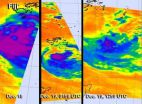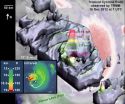(Press-News.org) The Bonn site of the German Center for Neurodegenerative Diseases (DZNE) and the University of Bonn are leading contributors.
The complex named "NLRP3 inflammasome" is composed of several proteins and plays a key role in the immune system. It resembles a fire alarm sensor that triggers a chain reaction when activated. As a result, immune cells are mobilized and substances that foster inflammation are released. This process can be triggered by infections, which are subsequently suppressed by the immune response. However, in the case of Alzheimer's disease, the activation of the molecular alarm may have negative consequences: nerve cells are damaged and die. Ultimately, this leads to the loss of brain function and mental capabilities in humans.
Alzheimer's disease is accompanied with deposits in the brain. That these so-called "plaques" have the capability to activate the NLRP3 inflammasome had already been identified by investigating individual cells. But the exact effect on the organism was unknown. "It was unclear what consequences an increased activity of the NLRP3 inflammasome could have on the brain," explains Prof. Michael Heneka, who conducts research at both, the DZNE and the University of Bonn. Working in a team with immune researcher Eicke Latz as well as with other colleagues, Heneka has now been able to show that the protein complex does in fact play a determining role in the development of Alzheimer's disease.
Studies involved humans and mice
The researchers collected a comprehensive chain of evidences: they examined both the brains of deceased Alzheimer patients and of mice who exhibited behavioural disorders that are typically associated with Alzheimer's disease. The researchers found an activated form of the NLRP3 inflammasome in both cases.
Looking at another group of mice, the scientists examined possibilities for suppressing inflammatory reactions. To achieve this, they removed the genes that trigger production of the NLRP3 inflammasome. Therefore, these mice were no longer able to synthesize the protein complex. As a result, the animals developed only relatively mild symptoms of the disease. Moreover, their brains showed only reduced amounts of the damaging plaques.
"We have stumbled upon a critical factor in the development process of Alzheimer's. Given these findings it appears to be a very promising possibility to block the activity of the inflammasome," comments Heneka. In his view, proper pharmaceuticals might be able to stop a chain reaction that would otherwise result in the inflammation of brain cells. "At present various options are being pursued to act upon the course of the disease," says the neuroscientist. "Our results points to a new possibility. Nevertheless, we are still in the process of doing basic research."
However, the group of scientists in Bonn is already making plans for the future. Eicke Latz's team, which also made significant contributions to the latest study, has already begun to search for active components that could block the NLRP3 inflammasome. "The testing of potential substances in the laboratory would be a next step. We hope to start as early as next year," says Heneka.
###
Original Publication:
"NLRP3 is activated in Alzheimer´s disease and contributes to pathology in APP/PS1 mice," Michael T. Heneka, Markus P. Kummer, Andrea Stutz, Andrea Delekate, Stephanie Schwartz, Ana Vieira Saecker, Angelika Griep, Daisy Axt, Anita Remus, Te-Chen Tzeng, Ellen Gelpi, Annett Halle, Martin Korte, Eicke Latz, Douglas Golenbock, Nature, DOI: 10.1038/nature11729
Alzheimer's disease: Cutting off immune response promises new approach to therapy
2012-12-20
ELSE PRESS RELEASES FROM THIS DATE:
Impact of caring for adult child with disability studied
2012-12-20
The study, published in Psychiatric Services, highlights economic and psycho-social challenges faced by parents of adult children with disabilities, compared with parents of children without disabilities.
When either parent becomes disabled, the study found, families' report lower financial well-being. This being especially true when an aging parent must contend with both the needs of an adult child with mental illness and a spouse who develops an age-related disability.
Not surprisingly, parents are themselves susceptible to developing disabilities and chronic conditions ...
Super-fine sound beam could one day be an invisible scalpel
2012-12-20
ANN ARBOR—A carbon-nanotube-coated lens that converts light to sound can focus high-pressure sound waves to finer points than ever before. The University of Michigan engineering researchers who developed the new therapeutic ultrasound approach say it could lead to an invisible knife for noninvasive surgery.
Today's ultrasound technology enables far more than glimpses into the womb. Doctors routinely use focused sound waves to blast apart kidney stones and prostate tumors, for example. The tools work primarily by focusing sound waves tightly enough to generate heat, says ...
Pigs in southern China infected with avian flu
2012-12-20
Researchers report for the first time the seroprevalence of three strains of avian influenza viruses in pigs in southern China, but not the H5N1 avian influenza virus. Their research, published online ahead of print in the Journal of Clinical Microbiology, has implications for efforts to protect the public health from pandemics.
Influenza A virus is responsible both for pandemics that have killed millions worldwide, and for the much less severe annual outbreaks of influenza. Because pigs can be infected with both human and avian influenza viruses, they are thought to ...
Transplanted neural stem cells slows als onset and progression in mouse models
2012-12-20
WORCESTER, MA – Promising new research provides evidence that ALS, amyotrophic lateral sclerosis (ALS), also known as Lou Gehrig's disease, may be treatable using neural stem cells. A consortium of researchers at multiple institutions, including the University of Massachusetts Medical School, Sanford-Burnham Medical Research Institute and Brigham and Women's Hospital, have shown that neural stem cells, when transplanted into the spinal cord of a mouse model with familial ALS, slow disease onset and progression while improving motor function, breathing and survival time ...
Study reveals that animals contribute to seagrass dispersal
2012-12-20
(December 19, 2012) Look out the window and you're likely to see the dispersal of seeds—dandelion tufts in the wind, a squirrel burying an acorn, a robin flying off with a dogwood fruit. You might even have a burr "velcroed" to your sock.
Sarah Sumoski, a recent graduate of the Virginia Institute of Marine Science, has now published a study of seed dispersal in a less-familiar environment—the eelgrass beds of Chesapeake Bay. The study—the first to show that marine animals can disperse eelgrass seeds—appears as the featured article in today's issue of Marine Ecology Progress ...
Time series of infrared NASA images show Cyclone Evan's decline
2012-12-20
Cyclone Evan is now far south of Fiji and wind shear and cooler sea surface temperatures have been taking their toll on the storm and weakening it. Infrared data from NASA's Aqua satellite has shown a quick decline in the storm's structure over one day.
A time series of infrared images from the Atmospheric Infrared Sounder (AIRS) instrument that flies aboard NASA's Aqua satellite showed changes in intense thunderstorms within Cyclone Evan between Dec. 18 and Dec. 19. Over a time period of 36 hours, Evan weakened from Cyclone strength to Tropical Storm strength. In an ...
NASA satellite finds an unusually tall storm-cell in Cyclone Evan
2012-12-20
NASA's Tropical Rainfall Measuring Mission or TRMM satellite found an unusually tall towering thunderstorm in Cyclone Evan.
According to Owen Kelley of the TRMM satellite team at NASA's Goddard Space Flight Center in Greenbelt, Md, the most startling feature of the December 16 overflight of Tropical Cyclone Evan was the extremely tall storm-cell in the north side of the eyewall. At the time TRMM passed overhead and captured an image of the storm, Evan was about to rake across the northern coast of the islands of Fiji.
The updrafts in this tower extended high enough ...
Why our backs can't read braille
2012-12-20
Johns Hopkins scientists have created stunning images of the branching patterns of individual sensory nerve cells. Their report, published online in the journal eLife on Dec. 18, details the arrangement of these branches in skin from the backs of mice. The branching patterns define ten distinct groups that, the researchers say, likely correspond to differences in what the nerves do and could hold clues for pain management and other areas of neurological study.
Each type of nerve cell that the team studied was connected at one end to the spinal cord through a thin, wire-like ...
NASA's Operation IceBridge data brings new twist to sea ice forecasting
2012-12-20
Shrinking Arctic sea ice grabbed the world's attention again earlier this year with a new record low minimum. Growing economic activity in the Arctic, such as fishing, mineral exploration and shipping, is emphasizing the need for accurate predictions of how much of the Arctic will be covered by sea ice. Every June, an international research group known as the Study of Environmental Arctic Change (SEARCH) publishes a summary of the expected September Arctic sea ice minimum known as the Sea Ice Outlook. The initial reports and monthly updates aim to give the scientific community ...
LSUHSC research discovery provides therapeutic target for ALS
2012-12-20
New Orleans, LA –Research led by Dr. Udai Pandey, Assistant Professor of Genetics at LSU Health Sciences Center New Orleans, has found that the ability of a protein made by a gene called FUS to bind to RNA is essential to the development of Amyotrophic Lateral Sclerosis (ALS). This discovery identifies a possible therapeutic target for the fatal neurological disease. The research will be available online in the Advanced Access section of the journal Human Molecular Genetics website, posted by December 21, 2012. It will be published in an upcoming issue of the journal.
...




